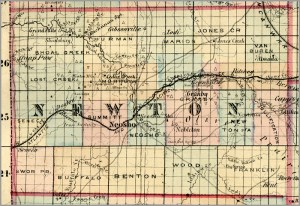Newton County, Missouri

- Formed: December 13, 1838
- County Population 1860: 8,895
- Slave Population 1860: 497
- Civil War Engagements
-The Neosho Affair, July 2, 1861
-The Battle of Shoal Creek, Dec. 27, 1861
-The First Battle of Newtonia, Sept. 30, 1862
-The Battle of Granby, October 4, 1862
-The Second Battle of Newtonia, Oct. 28, 1864
Image courtesy of Wilson’s Creek National Battlefield
Newton County, Missouri contains numerous fresh water sources, including Shoal Creek, School Creek, Indian Creek, Buffalo Creek, Lost Creek, Little Lost Creek, and Hickory Creek. Timber resources include oak, walnut, ash, hickory, elm, and maple. The soil is conducive for growing wheat, rye, oats, and corn as well as peaches, plums, apples, pears, grapes, and cherries. Newton County also contains several mineral resources, including lead, limestone, zinc, iron, copper, and calamine. Newton County also has abundant prairie lands and mineral springs.
The first white settlement was in 1830 by Colonel Lunsford Oliver and his family, after the Osage Indians were removed west in the 1820s. Gideon B. Henderson, Job Ratcliff, Hiram Estes, Hugh Shannon, John Plummer, George McInturf, Joseph Ross, Nathaniel Turner, and John Smith shortly followed the Oliver family. In 1831, Junius, Zenas, Lucius, and M.J. Rountree immigrated to the area in 1831 from Tennessee and raised cattle, horses, and mules. The Osage had nothing to hunt in the west, so returned to their former territory and raided settlers’ crops and livestock, but showed no violence toward the settlers themselves.
The county was officially established on December 13, 1838. Men from surrounding counties—John William of Taney County, James Williams of Barry County, and Chesley Cannifax of Greene County—named the county seat at Neosho. The name came from the Native American phrase “ne-o-zho,” which translates roughly to “clear and abundant water.” The first session of the county court was held at prominent resident John Reed’s home. Several townships were established by April, 1839. These were; Benton, Marion, Shoal Creek, Sugar Creek, Mosely (later Sarcoxie), and Elk River townships. Aside from eastern states and other areas in Missouri, a small number of settlers also came from Ireland, Germany, France, Canada, Scotland, Sweden, Norway, England, and Wales. By 1840, the population reached over 3,700 people. The population increased further when David Campbell discovered the first lead deposits and opened a commercial mine in 1849. This discovery led to the formation of Granby. By 1850, the county’s population grew to over 4,200 people. Newton County residents debated whether or not Kansas should enter the union as a slave or a free state, though they were not directly involved in crossing the border to vote in Kansas elections. However, the slave population in Newton County was 497 slaves in 1860.
When the Civil War began in 1861, Newton County residents were divided between the Confederacy and the Union, though there were not very many abolitionists in the county. Both armies came to Granby for lead to make ammunition. The “Neosho Company” was organized in October, 1860, and later joined the state guards under Captain Henderson Jennings. Several battles took place in Newton County boundaries. The Neosho Affair took place on July 2, 1861, and resulted in Union General Franz Sigel’s surrender to General Benjamin McCulloch’s troops. The Battle of Shoal Creek took place on December 27, 1861, fought principally between Union and Confederate Native American regiments, the 2nd Cherokee Mounted Rifles and the Federal Creeks and Seminoles. The Confederates attempted to retake the county on April 26, 1862 at a skirmish in Neosho between the First Missouri Cavalry (Union) and Confederate Indian regiments. Both sides claim they won the skirmish, however Union Col. Clark Wright had control of the county. On May 7, the Confederates conducted a successful raid to capture prisoners and to free some of their own men being held prisoner. On August 21, a skirmish in Neosho resulted in a Union victory.
The First Battle of Newtonia took place on September 30, 1862. After the Battle of Pea Ridge, in Benton County, Arkansas, Confederates left the area. However, by the end of September, they attempted to reclaim the region. The Confederates won the battle, but Union reinforcements caused a Confederate retreat into Arkansas. The Battle of Granby took place on October 4, 1862, resulting in a Union victory and Union control of the lead mines. By February 1863, Newton County was in Union Control. The Second Battle of Newtonia took place on October 28, 1864 between Confederate troops under General Sterling Price and Union troops under James G. Blunt and General Jo Shelby. Fighting raged until Federal cannon fire and reinforcements under Brig. Gen. John B. Sanborn finally caused the Confederates to retreat at nightfall. However, Shelby had accomplished his mission in holding up the Union pursuers. By morning, Price had retreated across the desolate prairie towards the Indian Territory, hindering Price’s raid of Missouri.
The war caused widespread destruction and devastation throughout Newton County. Much of Neosho was burned, and the two major battles in Newtonia left it almost totally deserted and destroyed. Skirmishes over the mines in Granby also left it devastated. By the 1870s, railroad and associated industry boom aided the county’s reconstruction.
 Browse all collections in Newton County
Browse all collections in Newton County
- Consulted:
- http://www.granbymo.com/content/modules.php?name=Content&pa=showpage&pid=4
- Reprint: McDonald and Newton County Sections of Goodspeed’s Newton Lawrence, Barry, and McDonald Counties, Missouri (McDonald County Historical Society, 1972).
- Reflection of Newton County, Missouri (Dallas, TX: Curtis Media Corporation. Dallas,1997).
- Newton County, 1860 U.S. Federal Census – Slave Schedules [database on-line]. Provo, UT, USA: Ancestry.com Operations Inc, 2004. Original data: United States of America, Bureau of the Census. Eighth Census of the United States, 1860. Washington, D.C.: National Archives and Records Administration, 1860. M653, 1,438 rolls.












